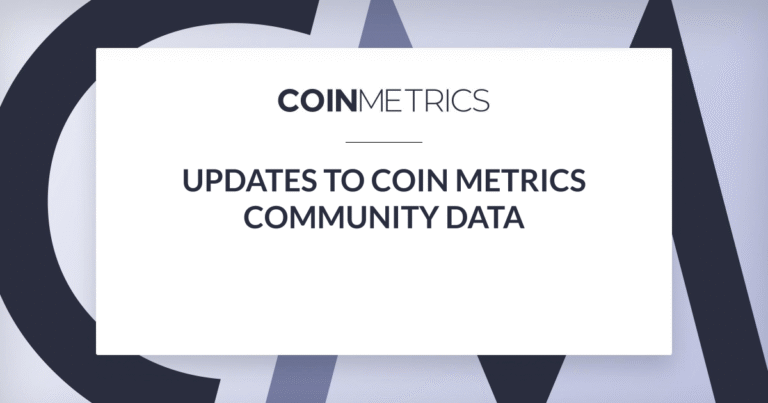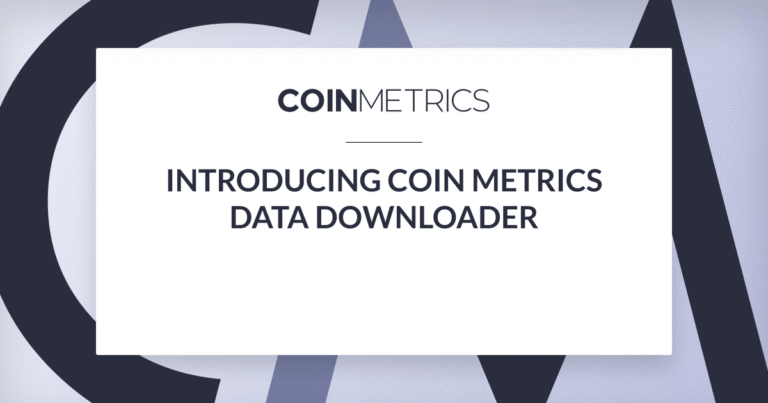Key Takeaways
- Using a new methodology that looks at addresses one hop out from the coinbase transaction, this report quantifies miner holdings and activity. This approach improves on previous attempts at tracking miner spending, which inadvertently measured pool operator activity rather than miner behavior.
- Miners accumulated an additional 318,000 BTC in the year leading up to the halving, from trough to peak.
- With supply held by miners gradually decreasing and net flows from their addresses stabilizing, miners appear to be exerting less influence on the network.
- Miner flow and supply metrics will be made available in the upcoming version 4.8 release of Network Data Pro.
Miners and Markets
In addition to their role in securing the network, miners have a profound effect on Bitcoin’s market dynamics. Because they can receive newly issued bitcoin rather than buying it, miners are natural net sellers of the asset. This effect is further compounded by the fact that miners’ operating expenses, chiefly electricity and rent, are primarily fiat-denominated, while their revenue is earned in bitcoin.
Using previously-unavailable data on accounts that have interacted with these addresses, this feature examines miners’ activity, assessing the drivers and impacts of their spending.
While on-chain data indicates miners’ influence on the network is gradually decreasing, they remain key players in the ecosystem with access to large amounts of capital. To help our users understand these actors, Coin Metrics is making a broad slice of miner-related data available in the upcoming version 4.8 release of Network Data Pro. Using this data, this feature finds that the supply held by miners has generally decreased over time and that the flows of funds to and from miners and pools have been dampened by the network’s successive halvings.
Summarizing Supply
To calculate miner flows, we begin by aggregating all addresses that have received payment from a coinbase transaction and labeling those as 0-hop addresses. All the addresses in this set, along with those that have received payment from an address in this set, are then tagged as 1-hop addresses.
Because of how mining pool wallets are typically structured, with pools initially receiving the block reward and only later distributing it to miners, 0-hop addresses generally represent mining pools and 1-hop addresses generally represent miners. For this reason, existing systems that attempt to extrapolate miner behavior from the spending habits of 0-hop addresses are theoretically unsound and do not measure what they purport to. Instead, they measure pool operators’ activity.
Admittedly, tagging miners and pools based on distance from a coinbase transaction is an imperfect technique. This is especially true when the methodology is applied to the early network, in which solo mining and alternative pool models were more popular. Because the first mining pool, Slush Pool, mined its first block in December of 2010, measurements from before this date in particular should only be used for reference. Furthermore, miner addresses that have not received funds from a 0-hop address will not be tagged. All told, though, this heuristic represents a significant improvement over the current state of the art and should accurately capture broad trends.
Miners, especially those active in the network’s early days, control a significant amount of bitcoin. The number of coins held by both 0-hop and 1-hop addresses has generally declined throughout the network’s history. H2 2019 and H1 2020 saw a significant reversal in this trend in the runup to the halving, however, with miners accumulating an additional 383,000 BTC from trough to peak. This effect was primarily confined to 1-hop addresses, with 0-hop supply remaining roughly flat—the bulk of this accumulation would therefore have remained undetected by previous estimation techniques.
Several jumps in the supply held by miners are visible. These spikes are typically caused by addresses with significant balances mining their first block or making their first interaction with a previously-tagged 0-hop address. The most prominent of these jumps occurred on August 16, 2012, when a whale holding over half a million BTC received part of the coinbase reward for block 194,256. New entrants were also responsible for the increase in miner-controlled supply before this year’s halving.
Due to inflation, the gradual reduction in supply held by miners and pools is even more significant when viewed in the context of total supply. This decrease is in line with a general increase in bitcoin’s supply dispersion. It’s also consistent with more widespread adoption of the pool model, which implies that non-mining addresses are becoming less likely to be superfluously tagged as 1-hop addresses.
Even today, though, miners and pools control a substantial chunk of the total bitcoin supply.
Pools and Payments
The flow of funds to and from these groups is another potent on-chain signal. Because pools are typically the immediate recipients of coinbase rewards, 0-hop flows are a useful indicator of mining pool activity. With the exception of several spikes, the most notable of which is attributable to the aforementioned whale, 0-hop inflows and outflows have both trended downward in BTC terms since the early days of the network.
Miner revenue, or income from block rewards, accounts for the bulk of 0-hop inflows. While miner revenue varies in the short term due to fluctuations in fees and the number of blocks mined, it is relatively stable across epochs.
While inflows and outflows are strongly correlated, outflows are much more volatile because they lack this protocol-mandated support, and because miners can choose when they would like to withdraw funds from mining pools’ wallets. The effects of the 2016 and 2020 halvings are apparent in a reduction in both types of flows. Since the 2020 halving, the value of inflows has generally exceeded that of outflows, a reversal of the historical norm.
Miners’ Money
While 0-hop flows are useful for tracking pool operators’ payments, in today’s standard wallet architecture, they do not represent transfers performed by miners themselves. In most pools, block rewards are instead received by an address controlled by the pool operator, who custodies funds until miners are paid out on a regularly-scheduled interval or choose to withdraw.
Under the pooled mining model, flows from addresses one hop out from the coinbase transaction more closely approximate miner spending. This report is one of the first attempts at analyzing 1-hop flows. Due to the much larger number of relevant addresses, the lack of an underlying support, and the high velocity of money, these flows are much larger and significantly more volatile than their 0-hop counterparts.
For analyzing flows in the early days of the network, before pools became the most common way to mine, 0-hop flows may be a more appropriate tool. Even today, 1-hop flows are only an approximation of miner activity, since pools’ wallet structures vary and exchange addresses may be erroneously included in these flows. By and large, though, this model represents a more holistic view of miner spending under today’s network conditions.
Like 0-hop flows, 1-hop inflows and outflows are closely related. Since block rewards represent only a small fraction of 1-hop inflows, both inflows and outflows are very volatile and the effect of the halving on this category of flows is less apparent.
Over the last year or so, flows to and from miner addresses have trended slightly upward, indicating heightened levels of activity. Because net flows have remained roughly constant and are generally becoming less volatile, this heightened activity does not appear to be reflected in an increase in influence on the broader network.
The tight coupling between inflows and outflows shows that miners, on aggregate, tend to move coins that come into their possession out of their addresses immediately. Given that derivatives marketplaces and fiat lenders typically require custody of coins, these flows do not rule out miners’ use of financial instruments to hedge their exposure to bitcoin’s price. However, survey data from Cambridge’s Third Global Cryptoasset Benchmarking Study suggests that adoption of these tools is low, with miners primarily relying on holding and selling bitcoin to meet their desired level of risk. The high amount of turnover then seems to indicate that miners are active market participants, habitually selling most newly-received coins.
Dollar Decisions
Because miners’ expenses, profits, and losses are dollar-denominated, viewing their flows through a dollar-value lens is useful. Since 0-hop flows are largely comprised of block rewards, the plot of their dollar values closely resemble that of miner revenue.
Because of their mutual dependence on the price of bitcoin, the plot of USD-denominated miner flows resembles that of pool flows on a larger scale. Unlike pool flows, though, miner flows have been trending upwards, even briefly surpassing their 2017 high in late 2019. This indicates broader miner activity across the network in dollar terms.
Compound Considerations
Viewed separately, inflows and outflows are useful for gauging the amount of economic activity that miners are engaging in.
For most of the network’s history, net flows from 0-hop addresses have been slightly negative, with these addresses typically spending more than they receive. While net flows were volatile in the network’s early days, their volatility has gradually decreased over time, likely due to the network’s halvings.
The dampening in 0-hop net flow volatility has continued in recent years. In the past few months, there’s been a reversal in the net flows’ historical negativity, with inflows slightly exceeding outflows since the most recent halving.
Like, 1-hop net flows are much more volatile than their 0-hop counterparts. Like 0-hop net flows, 1-hop net flows have generally been negative. These flows have also experienced a gradual dampening in volatility, indicating a gradual reduction in miners’ effect on liquidity.
Another tool for analyzing flows is the Miner’s Rolling Inventory, or MRI, which is the ratio of miner outflows to miner revenue. 0-hop MRI is useful for measuring whether miners are keeping their funds in mining pool wallets, represented by a ratio below 100%, or withdrawing them, represented by a value above 100%.
Since 0-hop flows are closely tethered to miner revenue, MRI has remained close to 100% for most of the network’s history. Volatility in this metric has gradually lowered in line with the dampening in 0-hop outflow volatility.
Compared to 0-hop MRI, 1-hop MRI provides a more accurate view of the relationship between miners’ spending habits and revenue. With 1-hop flows remaining comparatively flat throughout the network’s history and successive halvings reducing issuance, 1-hop MRI has grown in spurts. Because 1-hop spending is at about an order of magnitude higher than miner revenue, 1-hop MRI has measured in the thousands of percentage points for much of the network’s history.
Where do we go from here?
On-chain metrics like miners’ holdings and net transfer volumes indicate that miners’ influence on the network is slowly waning. Nonetheless, they’re still responsible for a substantial amount of activity, and control a significant portion of the total bitcoin supply. Some metrics, like gross flow volumes, also hint at increasing miner activity in both dollar and bitcoin terms.
As the only direct recipients of issuance, miners and pools also exercise a less-easily quantifiable influence on the network, and the metrics outlined in this article only scratch the surface of miner behavior. In the future, we hope to analyze flows from miners to exchanges, measuring their market impact more directly. We also hope to assess the active supply held by miner addresses, which would help to filter out lost coins from the network’s early days, as well as take into account individual pools’ wallet structures, ultimately allowing for a more granular assessment of miner behavior.
Thanks to Celia Wan for suggestions and edits.



